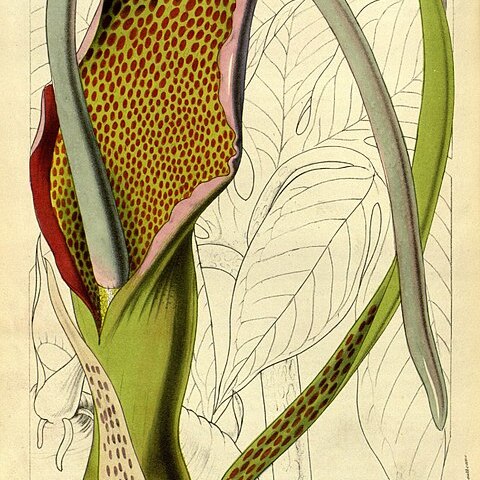Tuber depressed-globose, 4–10 cm. in diameter.. Petiole terete, up to 90 cm. long, green, often black-purple spotted or tinged brownish purple; blade kidney-shaped to subcircular in outline, 25–60 cm. broad, pedately-lobed; lobes 7–11, ovate-elliptic, acuminate, cuneate, deeply divided almost to base; central lobe usually obovate-elliptic, 12–30 cm. long, 5–16 cm. broad; lateral lobes progressively smaller.. Inflorescence appearing before leaves, with very strong carrion smell at anthesis, subtended by several oblong-lanceolate cataphylls; peduncle short, 2–8 cm. when in flower, subterranean, spathe borne at or partly below ground-level.. Spathe 25–50 cm. long; tube subcylindric with inflated ellipsoid basal part, 5–10 cm. long, 2–5 cm. in diameter, erect, outside dull purplish green, inside reddish purple, smooth; limb narrowly lanceolate-triangular, 20–40 cm. long, 3–9 cm. broad, reflexing and twisting spirally at maturity, inner surface pale yellow to pale green with numerous dark maroon-purple oblong to subcircular spots that are smaller towards base and merge near crisped-undulate margins.. Spadix 20–42 cm. long; sterile appendix cylindric, 14–30 cm. long, 0.5–1.6 cm. in diameter, erect at first, later curving forward, smooth, dull greyish green with cream base; staminate part cylindric, 1–1.7 cm. long, 0.5–1.5 cm. in diameter, sulphur yellow; sterile zone with cylindric, longitudinally ridged axis, 3.5–8 cm. long, 0.3–1.2 cm. in diameter, cream becoming purple apically, lowermost 1.5–2 cm. bearing 0.5–0.8 cm. long, horizontal to upward-curving, filiform to clavate, cream, sterile projections, with bluish-green, ± swollen tips; pistillate part cylindric to subconic, 0.7–1.6 cm. long, 0.6–1.4 cm. in diameter.. Ovary flask-shaped to cylindric, dark reddish-purple; ovules 1–2, pear-shaped, borne on massive basal placental cushion; stigma capitate, cream, 0.5 mm. in diameter.. Berries obovate, 0.9–1 cm. long, ± 0.8 cm. in diameter, 1–2-seeded, mulberry purple to red, borne at or partly below ground-level in tight subglobose head up to 4 cm. in diameter.. Seed obovate, 0.7–0.8 cm. long, 0.45–0.55 cm. in diameter; testa fleshy, dark spotted; embryo small, central, cylindric; endosperm copious.. Fig. 15.
More
Tuber depressed globose, to ca. 9 cm high and ca. 15 cm in diam., producing numerous annual offsets, these globose or depressed globose. Petiole yellowish green, with rounded purplish brown spots, 20-100 cm; leaf blade 9-11-pedatifid; central lobe oblong or oblong-elliptic to oblanceolate, 10-40 × 4-20 cm, acuminate; lateral leaflets elliptic, gradually smaller toward distal end of rachis. Inflorescence appearing before leaves; peduncle greenish white, with or without a few brown spots, 3-7 cm, sometimes elongating during fruiting. Spathe base outside dull dark violet, inside rich reddish purple, ellipsoid, 5-10 × 2-4 cm; limb convolute at base, ca. 10 cm, distally outside as base but slightly darker and with a few violet longitudinal stripes, inside background color yellowish, almost entirely covered by numerous orbicular to elliptic, confluent dark purple spots, lanceolate, 30-70 × 8-10 cm, apex acuminate. Spadix slightly shorter than or as long as spathe; female zone subcylindric, 2-2.5 × 1-1.5 cm; ovary violet or pale purple, obovoid, 2-4-ovuled; sterile zone 8-8.5 cm, proximal 2-2.5 cm sparsely covered with long staminodes, distally grooved and with a few distant conic projections, proximally whitish, distally pale brownish violet; staminodes yellow, clavate, 4-10 mm; male zone 1-2 × 1-1.5 cm; stamens yellow; appendix at first erect, finally recurved, pale brown to pale violet or lead-colored, terete, to 30 cm, ca. 1 cm in diam. at base, obtuse. Fruiting zone globose or subcylindric, naked, to ca. 9 cm in diam.; berries crowded, bright purple, cylindric, 5-10 × 2-4 mm, angulate, apex truncate. Fl. Apr-May, fr. Jul.
A herb which forms tubers. The corm can be 13 cm across. The leaf stalk is mottled black. It forms leaves after flowering. The leaf occurs singly and has 7-15 variable lobes. The interior of the spathe is speckled. The flower stalk or spadix is finger-like. The fruit are red berries. The seeds are oval and 1.8 mm across. The flower has a bad smell. The leaves appear after flowering.


